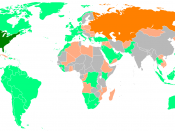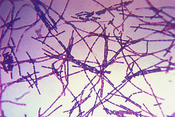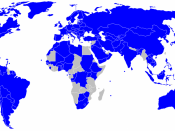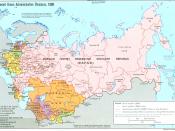Biological weapons were invented and used several centuries ago, even though one may think that biological weapons are a modern invention. During the French and Indian war, in mid-1700, British soldiers gave smallpox-infested blankets to American Indians with hopes that they get infected and will die. This might seem as a very primitive example of the biological warfare, but at that time there were no advanced technologies to cultivate and improve the biological weapons. In modern times, however, where the wars became more expansive and when there were many technological advances, the biological weapons became of a high concern and a great demand. Developed countries such as Soviet Union, United States, Germany, France, Great Britain and Japan began exploiting in the biological warfare area.
The results of the biological weapons research was seen already during the WWI where the Germans used the poison gas against the Allied troops, which resulted in 100,000 deaths and 900,000 injuries from the both sides.
Even though the gas was a chemical weapon it went hand in hand with the biological weapons. After the WWI the research on biological weaponry only increased. The countries thought that using germs to kill enemies rather than their own soldiers to kill enemies was a far better option. Huge sums of money were poured into various experiments with biological weapons. One of such countries to spend a lot of money on bio weapons was Soviet Union.
The Soviet Union?s involvement with biological weapons began with the start of the Cold War. Cold War was an arms race between the United States and the Soviet Union. Both countries wanted to have better weapons, better technology, better everything. This competition spurred Soviet Union?s involvement in creation of bio weapon research industry. Facilities were built all across the Soviet Union to research, produce and store the biological weapons. By the 1970 the countries all over the world became concerned with the dangers of the biological weapons. In 1972 the Biological Weapons Convention was organized in Geneva aimed at outlawing the production and stockpiling of the biological weapons. Over 140 countries participated in the convention including the Soviet Union.
The Soviet Union after signing the treaty did not stop producing the biological weapons, however. For this nation the treaty was only the beginning for massive production of the bio weapons. This operation, of course, was run in deep secrecy because it was an obvious violation of the Biological Weapons Convention. The scheme was only fully uncovered after the break-up of the Soviet Union. This is what the world has found out: there had been more than one hundred bio warfare facilities throughout the Soviet Union, which employed over 60,000 scientists.
The biggest and the deadliest facility of all, was uncovered in Stepnogorsk that did not even exist on the map. This facility was built in 1982 to develop and manufacture a more lethal variant of anthrax. It employed about a half of all the scientists involved in Russian bio warfare, which is 30,000 employees. It had an annual budget of almost $1 billion U.S. and was so enormous that if producing anthrax at full capacity for a production cycle of 220 days it could make 300 tons of anthrax spores. This could have been enough to wipe out the entire United States population. This is pretty scary, considering that this whole thing was run completely in secret. Besides producing anthrax in one of those facilities, the Soviet Union was producing other deadly biological weapons such as plague and smallpox. These diseases were also produced in large quantities just as anthrax was. The break-up of the Soviet Union uncovered these secretly run facilities and the production was stopped.
The break-up of the Soviet Union, however, did not eradicate the problem of the biological warfare since most of the Russian scientists who were working for Russian military left for other countries. The other problem was that the break-up produced a widespread realization of threat of biological weapons. For example, it was learned that the Soviet Union has turned smallpox into a biological weapon. Before the break-up, smallpox was considered a conquered disease because the vaccinations against it were proven effective. In 1970, the U.S. and some other countries simply stopped vaccinating against the smallpox. But now we see a different picture, especially in light of the September 11th terrorist attacks. The United States, for example, has just spent $428 million to order 209 million doses of vaccine in case of the future terrorist attacks.
As one can see, the Soviet Union played an important role in developing and stockpiling biological weapons even after signing the Biological Weapons Convention. Anthrax, smallpox and other disease were produced in enormous amounts to pose a serious threat to many nations in the world. After the break-up of the Soviet Union the threat ceased. But now, there are other countries in the world that pose such a threat.




